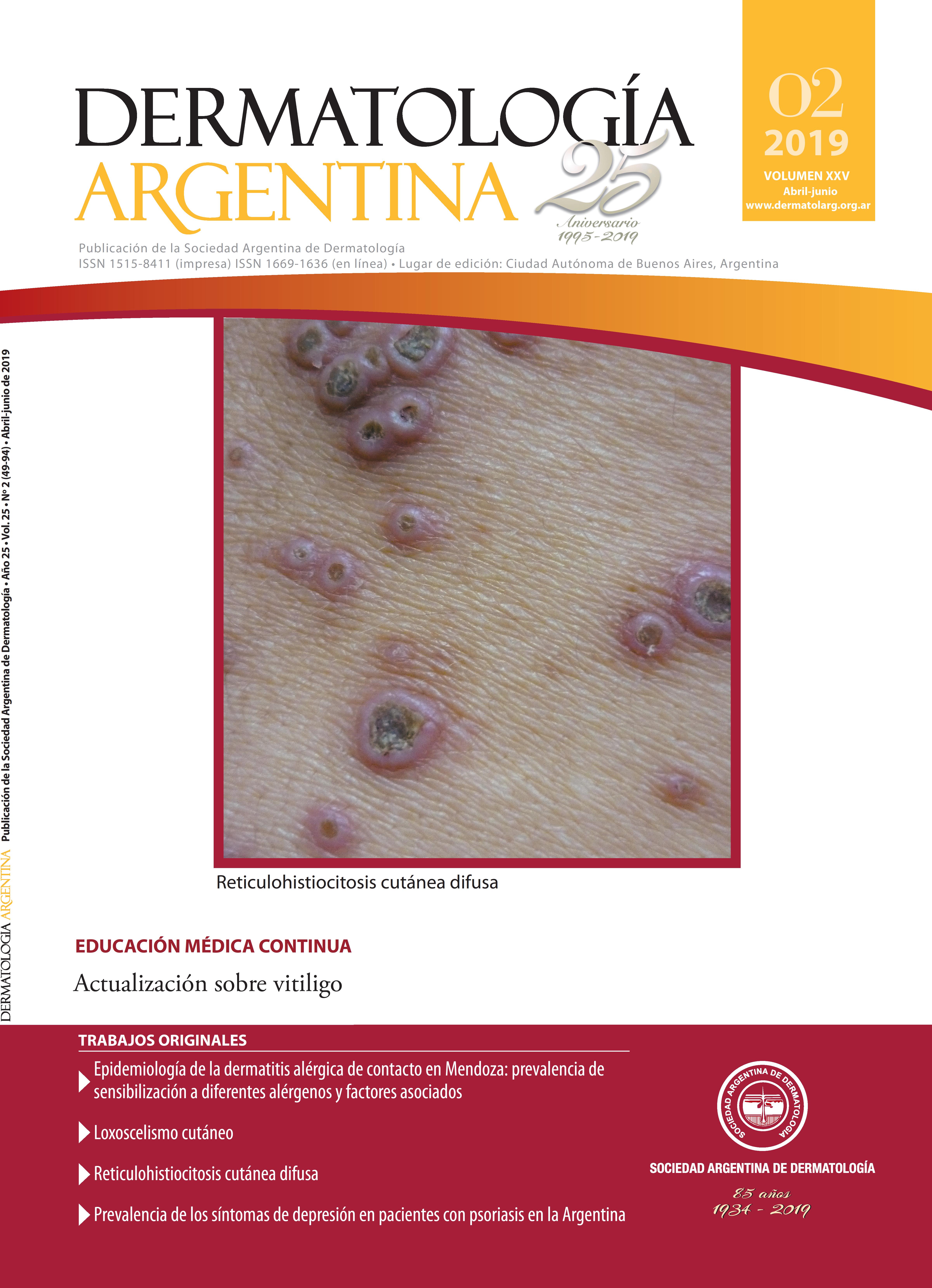Vitiligo update
Keywords:
vitiligo, hypomelanosis, vitiligo treatmentAbstract
Vitiligo is an acquired hypomelanosis that manifest clinically through progressive appearance of acromic and hypochromic macules of great esthetic impact. Although the etiopathogenesis of vitiligo is unknown, different theories have been presented, being the immunity theories the most accepted one. There are multiple therapies available and in
recent years, emerging treatments have emerged based on the state of the knowledge of the pathogenesis of this entity.
References
I. Alikhan A, Felsten LM, Daly M, Petronic-Rosic V. Vitiligo: a comprehensive overview. Part I. Introduction, epidemiology, quality of life, diagnosis, differential diagnosis, associations, histopathology, etiology, and work-up. J Am Acad Dermatol 2011;65:473-91.
II. Ortiz L, Gardea LM, Luna V, Levario-Carrillo M, et ál. Vitiligo en niños y su asociación con otras patologías. Dermatol Pediatr Lat 2003;1:18-23.
III. Manolache L, Petrescu-Seceleanu D, Benea V. Correlation of stressful events with onset of vitiligo in children. J Eur Acad Dermatol Venereol 2009;23:187-188.
IV. Goh BK, Pandya AG. Presentations, signs of activity, and differential diagnosis of vitiligo. Dermatol Clin 2017;35:135-144.
V. Yaghoobi R, Omidian M, Bagherani N. Vitiligo: a review of the published work. J Dermatol 2011;38:419–431.
VI. Ezzedine K, Mahé A, van Geel N, Cardot-Leccia N, et ál. Hypochromic vitiligo: delineation of a new entity. Br J Dermatol 2015;172:716-721.
VII. Chaparro EN, Rosati OM, Hassan ML. Vitiligo nuestra casuística en 270 casos. Arch Argent Dermatol 2011;61:191-196.
VIII. Ezzedine K, Amazan E, Seneschal J, Cario-André M, et ál. Follicular vitiligo: a new form of vitiligo. Pigment Cell Melanoma Res 2012;25:527–529.
IX. Ezzedine K, Lim HW, Suzuki T, Katayama I, et ál. Revised classification/nomenclature of vitiligo and related issues: the Vitiligo Global Issues Consensus Conference. Pigment Cell Melanoma Res 2012;25:1-13.
X. Rashighi M, Harris JE. Vitiligo pathogenesis and emerging treatments. Dermatol Clin 2017;35:257-265.
XI. Zúñiga Rosales Y, González-Herrera Y, Miyares-Díaz E, Rodríguez-Pelier CV. Hipotesis autoinmune. Rev Biomed 2014;25:145-155.
XII. MacDonald BT, Tamai K, He X. Wnt/β-catenin signaling: components, mechanisms, and disease. Dev Cell 2009;17:9-26.
XIII. Regazzetti C, Joly F, Marty C, Rivier M. Transcriptional analysis of vitiligo skin reveals the alteration of WNT pathway: a promising target for repigmenting vitiligo patients. J Invest Dermatol 2015;135:3105-3114.
XIV. Zhang BX, Lin M, Yi Qi X, Zhang RX, et ál. Characterization of circulating CD8+T cells expressing skin homing and cytotoxic molecules in active non-segmental vitiligo. Eur J Dermatol 2013;23:331-338.
XV. Pereira Antelo D, Lima Filgueira A, Telles Cunha JM. Reduction of skin-homing cytotoxic T cells (CD81–CLA1) in patients with vitiligo. Photodermatol Photoimmunol Photomed 2011;27:40-44.
XVI. Spritz RA, Andersen GHL. Genetics of Vitiligo. Dermatol Clin 2017;35:245-255.
XVII. Czajkowski R, Męcińska-Jundziłł K. Current aspects of vitiligo genetics. Postepy Dermatol Alegol 2014;31:247-255.
XVIII. Harris JE. Chemical-induced vitiligo. Dermatol Clin 2017;35:151-161.
XIX. Wu CS, Yu HS, Chang HR, Yu CL, et ál. Cutaneous blood flow and adrenoceptor response increase in segmental-type vitiligo lesions. J Dermatol Sci 2000;23:53–62.
XX. Malieni D. Manejo del vitiligo. Guía de Práctica Clínica. Evid Actual Pact Ambul 2006:9;58-60.
XXI. Papadopoulos L, Bor R, Legg C, Hawk JLM. Impact of life events on the onset of vitiligo in adults: preliminary evidence for a psychological dimension in aetiology. Clin Exp Dermatol 1998;23:243-248.
XXII. Lee HJ, Park MK, Kim SY, Park Choo, et ál. Serotonin induces melanogenesis via serotonin receptor 2A. Br J Dermatol 2011;165:1344-1348.
XXIII. Valbuena MC; Patiño LA. Psoriasis lineal y vitiligo segmentario, manifestación sobrepuesta de dos enfermedades frecuentes [en línea]. Rev Argent Dermatol 2013;94(1). Disponible en:<http://www.scielo.org.ar/scielo.php?script=sci_ arttext&pid=S1851-300X2013000100004&lng=es&nrm=iso> [Consultado febrero 2018].
XXIV. Nai GA, Miot LBD, Miot HA, Marques MEA. Imuno-histoquímica para o diagnóstico precoce de vitiligo. Immunohistochemistry for early diagnosis of vitiligo. J Bras Patol Med Lab 2008;44:367-373.
XXV. Faria AR, Tarié RG, Dellatorre G, Mira MT. Vitiligo-Part 2-classification, histopathology and treatment. An Bras Dermatol 2014;89:784-790.
XXVI. Narita T, Oiso N, Fukai K, Kabashima K, et ál. Generalized vitiligo associated autoimmune diseases in Japanese patients their families. Allergol Int 2011;60:505-508.
XXVII. Sheth VM, Guo Y, Qureshi AA. Comorbidities Associated with Vitiligo: A Ten-Year Retrospective Study. Dermatology 2013;227:311-315.
XXVIII. Akay BN, Bozkir M, Anadolu Y, Gullu S. Epidemiology of vitiligo, associated autoimmune diseases and audiological abnormalities: Ankara study of 80 patients in Turkey. J Eur Acad Dermatol Venereol 2010;24:1144-1150.
XXIX. Wagoner MD, Albert DM, Lerner AB, Kirkwood J, et ál. New observations on vitiligo and ocular disease. Am J Ophthalmol 1983;96:16-26.
XXX. Tsuruta D, Hamada T, Teramae H, Mito H, et ál. Inflammatory vitiligo in Vogt-Koyanagi-Harada disease. J Am Acad Dermatol 2001;44:129-131.
XXXI. Rodrigues M, Ezzedine K, Hamzavi I, Pandya AG, et ál. New discoveries in the pathogenesis and classification of vitiligo. J Am Acad Dermatol 2017;77:1-13.
XXXII. Ezzedine K, Eleftheriadou V, Whitton M, Van Geel N. Vitiligo. Lancet 2015;386:74-84.
XXXIII. Feily A. Vitiligo Extent Tensity Index (VETI) score: a new definition, assessment and treatment evaluation criteria in vitiligo. Dermatol Pract Concept 2014;4:81-84.
XXXIV. Pasricha JS, Khaitan BK. Oral mini-pulse therapy with betamethasone in vitiligo patients having extensive or fast-spreading disease. Int J Dermatol 1993;32:753-757.
XXXV. Kanwar AJ, Mahajan R, Parsad D. Low-dose oral mini-pulse dexamethasone therapy in progressive unstable vitiligo. J Cutan Med Surg 2013;17:259-268.
XXXVI. Passeron T. Medical and maintenance treatments for vitiligo. Dermatol Clin 2017;35:163-170.
XXXVII. Singh H, Kumaran MS, Bains A, Parsad D. A Randomized comparative study of oral corticosteroid minipulse and low-dose oral methotrexate in the treatment of unstable vitiligo. Dermatology 2015;231:286-290.
XXXVIII. Singh A, Kanwar AJ, Parsad D, Mahajan R. Randomized controlled study to evaluate the effectiveness of dexamethasone oral therapy versus oral minocycline in patients with active vitiligo vulgaris. Indian J Dermatol Venereol Leprol 2014;80:29-35.
XXXIX. Taieb A, Alomar A, Böhm M, Dell’anna M, et ál. Guidelines for the management of vitiligo: the European Dermatology Forum consensus. Br J Dermatol 2013;168:5-19.
XL. Ho N, Pope E, Weinstein M, Greenberg S, et ál. A double-blind, randomized, placebo-controlled trial of topical tacrolimus 0,1% vs. Clobetasol propionate 0,05% in childhood vitiligo. Br J Dermatol 2011;165:626-632.
XLI. Díaz Mathé A, González VM, Llorca V, Losada K, et ál. Experiencia en el tratamiento del vitiligo utilizando UVB pulsado de banda ancha y tacrolimus tópico. Dermatol Argent 2011;17:134-139.
XLII. Rojas López RF, Vergara Rueda JI. Fototerapia con radiación ultravioleta (UVB) de banda estrecha: una opción segura de manejo para vitiligo y otras dermatosis. Med UNAB 2010;13:38-43.
XLIII. Parsad D, Kanwar AJ, Kumar B. Psoralen–ultraviolet A vs. narrow-band ultraviolet B phototherapy for the treatment of vitiligo. J Eur Acad Dermatol Venereol 2006;20:175-177.
XLIV. Mouzakis JA, Liu S, Cohen G. Rapid response of facial vitiligo to 308nm Excimer Laser and Topical Calcipotriene. J Clin Aesthet Dermatol 2011;4:41-44.
XLV. Coringrato M, Cergneux F. Técnicas quirúrgicas en tratamiento de vitiligo. Dermatol Argent 2014;20:284-289.
XLVI. Czajkowski R, Placek W, Drewa T, Kowaliszyn B, et ál. Autologous cultured melanocytes in vitiligo treatment. Dermatol Surg 2007;33:1027-1036.
XLVII. Mulekar SV. Long-term follow-up study of 142 patients with vitiligo vulgaris treated by autologous, non-cultured melanocyte-keratinocyte cell transplantation. Int J Dermatol 2005;44:841-845.
XLVIII. Gupta D, Kumari R, Thappa DM. Depigmentation therapies for vitiligo. Indian J Dermatol Venereol Leprol 2012;78:49-58.
XLIX. Rodrigues M, Ezzedine K, Hamzavi I, Pandya AG, et ál.Current and emerging treatments for vitiligo. J Am Acad Dermatol 2017;77:17-29.
L. Dell’Anna ML, Mastrofrancesco A, Sala R, Venturini M, et ál. Antioxidants and narrow band-UVB in the treatment of vitiligo: a double-blind placebo controlled trial. Clin Exp Dermatol 2007;32:631-636.
LI. Craiglow BG, King BA. Tofacitinib citrate for the treatment of vitiligo: a pathogenesis-directed therapy. JAMA Dermatol 2015;151:1110-1112.
LII. Joshipura D, Alomran A, Zancanaro P, Rosmarin D. Treatment of vitiligo with the topical Janus kinase inhibitor ruxolitinib: A 32-week open-label extension study with optional narrow-band ultraviolet B. J Am Acad Dermatol 2018;78:1205-1207.
LIII. Noël M, Gagné C, Bergeron J, Jobin J, et ál. Positive pleiotropic effects of HMG-CoA reductase inhibitor on vitiligo. Lipids Health Dis 2004;3:1-5.
LIV. Rashighi M, Harris JE. Interfering with the IFN-γ/CXCL10 pathway to develop new targeted treatments for vitiligo. Ann Transl Med 2015;3:43.
LV. Brigham and Women’s Hospital. Open-label pilot study of abatacept for the treatment of vitiligo [en línea]. NHI Phase I Clinical Trial. Active, not recruiting. Disponible en: <https://clinicaltrials.gov/ct2/show/study/ NCT02281058?view=record> [Consultado febrero 2018].
LVI. Herrero-Beaumont G, Martínez Calatrava MJ, Castañeda S. Mecanismo de acción de abatacept: concordancia con su perfil clínico. Reumatol Clin 2012;8:78-83.
LVII. Lim HW, Grimes PE, Agbai O, Hamzavi I, et ál. Afamelanotide and narrowband UV-B phototherapy for the treatment of vitiligo. JAMA Dermatol 2015;151:42-50.
Downloads
Published
Issue
Section
License
El/los autor/es tranfieren todos los derechos de autor del manuscrito arriba mencionado a Dermatología Argentina en el caso de que el trabajo sea publicado. El/los autor/es declaran que el artículo es original, que no infringe ningún derecho de propiedad intelectual u otros derechos de terceros, que no se encuentra bajo consideración de otra revista y que no ha sido previamente publicado.
Le solicitamos haga click aquí para imprimir, firmar y enviar por correo postal la transferencia de los derechos de autor












